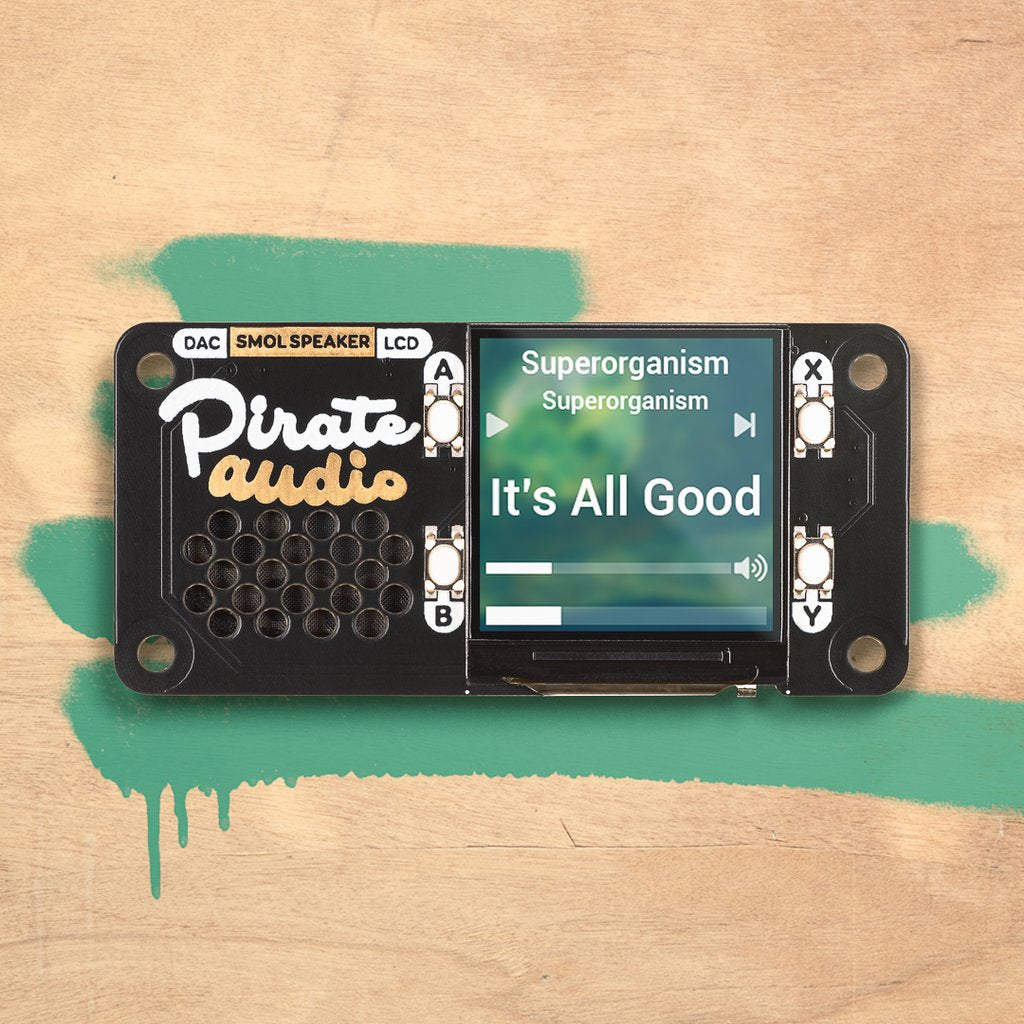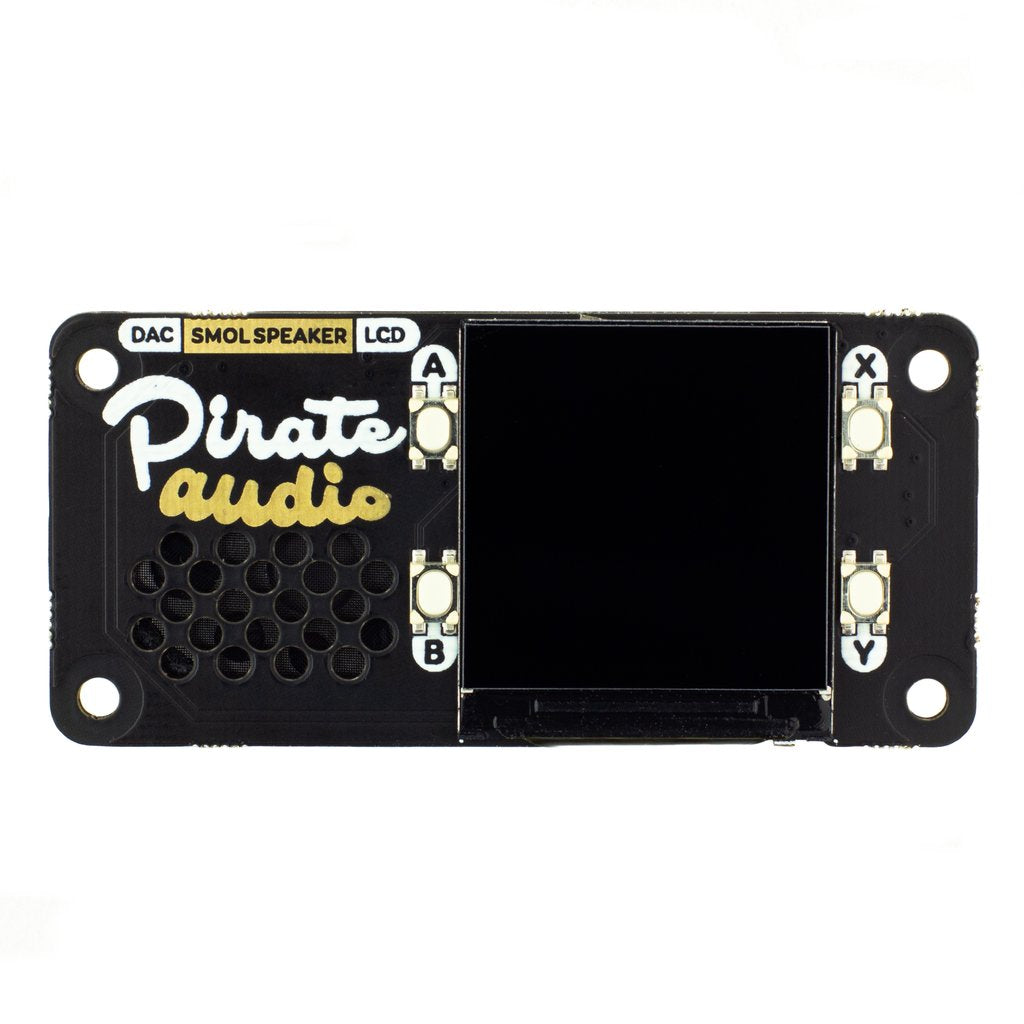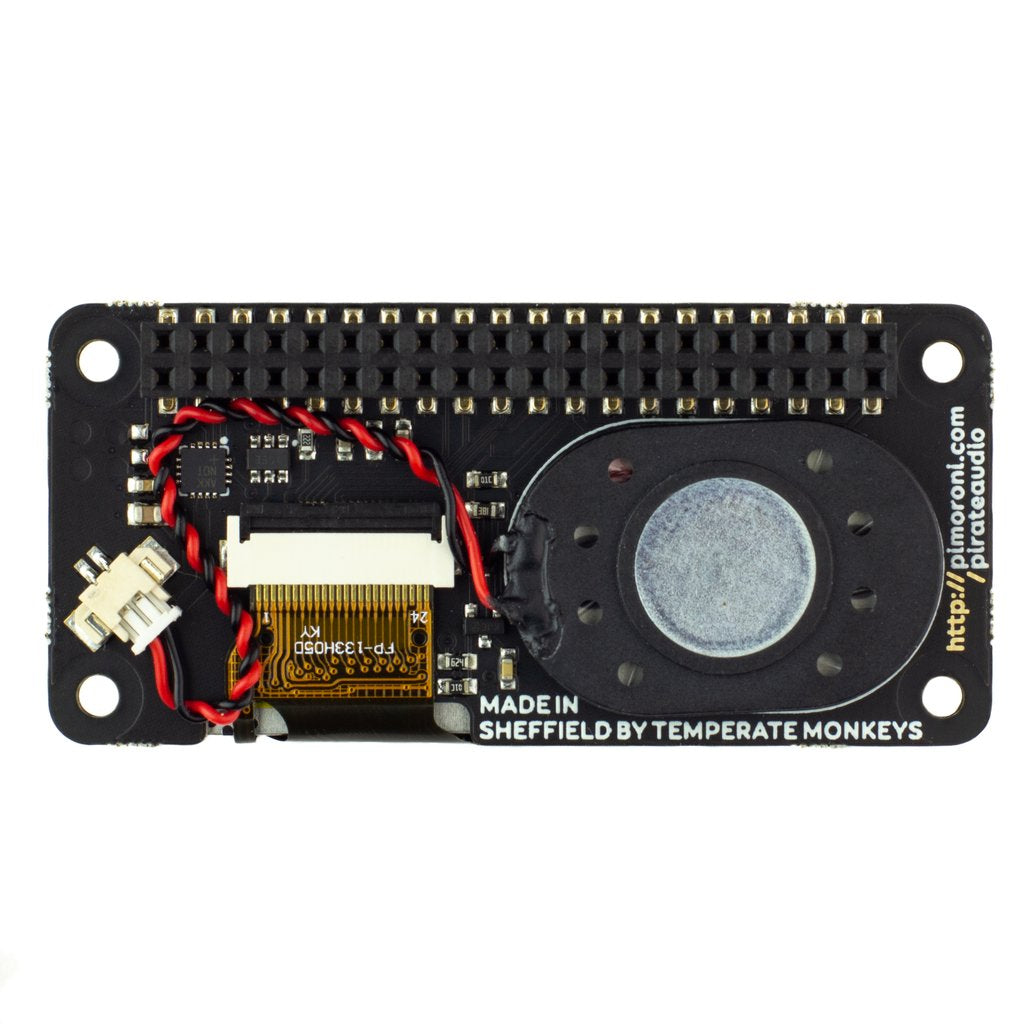Dieses winzige Soundsystem verfügt über einen I2S-DAC, einen Verstärker, einen Mini-Mono-Lautsprecher, ein hochauflösendes Display und Tasten zur Wiedergabesteuerung.
Pirate Audio Speaker eignet sich perfekt für ein Liliputaner-Radio, einen Soundeffekt-Player oder sogar als winzige Spielekonsole! Der eingebaute 1-W-Lautsprecher ist nicht der lauteste, aber er macht bei vielen Projekten Spaß. Mit dem Display und den Wiedergabetasten können Sie Ihre Audio- oder Soundeffekte im Handumdrehen steuern. Nutzen Sie unsere Pirate Audio Software (mehr Infos unten), um lokale Audiodateien (MP3, FLAC, etc.) abzuspielen oder von Diensten wie Spotify zu streamen.
Pirate Audio ist eine Reihe von All-in-One-Audio-Boards für den Raspberry Pi, mit hochwertiger digitaler Audioqualität, wunderschön gestalteten IPS-Displays für Album-Cover, taktilen Tasten für die Wiedergabesteuerung und unserer maßgeschneiderten Pirate Audio Software und Installationsprogramm, um die Einrichtung zum Kinderspiel zu machen.
Merkmale
- MAX98357A DAC/Verstärker-Chip (Datenblatt)
- Mono-Audio
- Mini-Lautsprecher (1W / 8Ω, angeschlossen)
- Push-fit-Lautsprecheranschlüsse
- 1,3" IPS-Farb-LCD (240x240px) (ST7789-Treiber)
- Vier taktile Tasten
- Platine im Mini-HAT-Format
- Vollständig bestückt
- Kompatibel mit allen Raspberry Pi-Modellen mit 40-poliger Stiftleiste
- Software Pirate Audio
- Abmessungen: 65x30,5x9,5mm
Software
Pimoronis Pirate Audio Software und Installer installiert die Python-Bibliothek für das LCD, konfiguriert das I2S-Audio und SPI und installiert dann Mopidy und unsere benutzerdefinierten Pirate Audio Plugins, um Album-Cover und Track-Infos anzuzeigen und die Tasten für die Wiedergabesteuerung zu verwenden.
Hier ist, wie Sie loslegen:
Legen Sie eine SD-Karte mit der neuesten Version von Raspbian an.
Verbinden Sie sich mit Wi-Fi oder einem kabelgebundenen Netzwerk.
Öffnen Sie ein Terminal und geben Sie das Folgende ein:
git clone https://github.com/pimoroni/pirate-audio
cd pirate-audio/mopidy
sudo ./install.sh
Starten Sie Ihren Pi neu
Eine detailliertere Anleitung finden Sie hier: https://github.com/pimoroni/pirate-audio/tree/master/mopidy. Weitere Informationen finden Sie in unserem Tutorial "Erste Schritte mit Pirate Audio".
Hinweise
Beachten Sie, dass unser Installationsprogramm, das oben verlinkt ist, alle unten aufgeführten Schritte für Sie erledigt, aber wenn Sie ein unerschrockener Hacker sind, müssen Sie diese Dinge vielleicht wissen!
Der DAC kann durch Hinzufügen von dtoverlay=hifiberry-dac in der Datei /boot/config.txt konfiguriert werden.
Es gibt einen DAC-Enable-Pin-BCM 25-, der auf High getrieben werden muss, um den DAC zu aktivieren. Sie können dies erreichen, indem Sie gpio=25=op,dh in die Datei /boot/config.txt eintragen.
Die Tasten sind aktiv low und mit den Pins BCM 5, 6, 16 und 20 verbunden.
Das Display verwendet SPI, und Sie müssen SPI über das Konfigurationsmenü des Raspberry Pi aktivieren.
English description
Pump out some mini beats with Pirate Audio Speaker! This diminutive sound system has an I2S DAC, amp, mini mono speaker, high-res display, and playback control buttons.
Pirate Audio Speaker is perfect for making a Lilliputian radio, sound effect player, or even as a teeny-weeny games console! The built-in 1W speaker isn't the loudest but it's great fun for lots of projects. The display and playback buttons let you control your audio or sound effects in a jiffy. Use our Pirate Audio software (more info below) to play local audio files (MP3, FLAC, etc) or stream from services like Spotify.
Pirate Audio is a range of all-in-one audio boards for Raspberry Pi, with high-quality digital audio, beautifully-crisp IPS displays for album art, tactile buttons for playback control, and our custom Pirate Audio software and installer to make setting it all up a breeze.
Features
- MAX98357A DAC / amplifier chip (datasheet)
- Mono audio
- Mini speaker (1W / 8Ω, attached)
- Push-fit speaker terminals
- 1.3" IPS colour LCD (240x240px) (ST7789 driver)
- Four tactile buttons
- Mini HAT-format board
- Fully-assembled
- Compatible with all 40-pin header Raspberry Pi models
- Pirate Audio software
- Dimensions: 65x30.5x9.5mm
Software
Pimoroni's Pirate Audio software and installer installs the Python library for the LCD, configures the I2S audio and SPI, and then installs Mopidy and our custom Pirate Audio plugins to display album art and track info, and to use the buttons for playback control.
Here's how to get started:
- Set an SD card up with the latest version of Raspbian.
- Connect to Wi-Fi or a wired network.
- Open a terminal and type the following:
git clone https://github.com/pimoroni/pirate-audio
cd pirate-audio/mopidy
sudo ./install.sh
- Reboot your Pi
You can find more detailed instructions here: https://github.com/pimoroni/pirate-audio/tree/master/mopidy or get tonnes more info in our Getting Started with Pirate Audio tutorial.
Notes
Note that our installer, linked above, does all of the below for you, but if you're an intrepid hacker then you might need to know this stuff!
- The DAC can be configured by adding
dtoverlay=hifiberry-dacto the/boot/config.txtfile. - There is a DAC enable pin—BCM 25— that must be driven high to enable the DAC. You can do this by adding
gpio=25=op,dhto the/boot/config.txtfile. - The buttons are active low, and connected to pins BCM 5, 6, 16, and 20
- The display uses SPI, and you'll need to enable SPI through the Raspberry Pi configuration menu.



